Eyal Meir Berkowitz's talent for explaining complex Mishnayot was recognized by rabbis and experts in the field. On December 7, 2023, Eyal fell in an IDF operation extracting the bodies of hostages abducted to Gaza. His family decided to cherish his memory by handing his work over to the National Library of Israel. Eyal Berkowitz studied for many years in the Bnei David Hesder Yeshiva in Eli. During his studies there, he joined a group studying the Mishnah. For many years, he wrote brief notes on almost every Mishnah passage. I am involved in researching diagrams drawn by Rishonim, and what resonated with me was that Eyal drew his own diagrams to illustrate the text. I was able to access Eyal's copy of Mishnayot which has been digitized by the NLI, and have analyzed some of the diagrams he drew, especially as compared with those of the Rambam in his Peirush HaMishnayot.
Eyal’s Mishnayot under the bibliographic record of הערות סביב ששה סדרי משנה בהוצאת "משנה סדורה" תשס"ז are available here[i]
The following is a close look at the diagram presented in Eruvin 2:1, the famous Sugya of "פסי ביראות", a leniency which was instituted for עולי רגלים. We will study the diagram in the Peirush HaMishnayot of the Rambam and then look at the diagrams drawn by Eyal Berkowitz in his own Peirush HaMishnayot
Our focus is on the first part of the Mishnah which describes two opinions on what is needed for this artificial fence around the well.
תלמוד בבלי מסכת עירובין פרק ב׳ משנה א׳
עוֹשִׂין פַּסִּין לַבֵּירָאוֹת אַרְבָּעָה דְיוּמְדִין, נִרְאִין כִּשְׁמֹנָה, דִּבְרֵי רַבִּי יְהוּדָה. רַבִּי מֵאִיר אוֹמֵר, שְׁמֹנָה, נִרְאִין כִּשְׁנֵים עָשָׂר, אַרְבָּעָה דְיוּמְדִין וְאַרְבָּעָה פְשׁוּטִין. גָּבְהָן עֲשָׂרָה טְפָחִים, וְרָחְבָּן שִׁשָּׁה, וְעָבְיָן כָּל שֶׁהוּא
One may arrange upright boards [פַּסִּין] around a well in Reshut HaRabim. It is sufficient if there are four double posts [דְיוּמְדִין] that look like eight single posts, i.e., four corner pieces, each comprised of two posts joined together at right angles; this is the opinion of Rav Yehuda. Rav Meir says: There must be eight posts that look like twelve.How so? There must be four double posts, one in each corner, with four plain posts, one between each pair of double posts. The height of the double posts must be at least ten Tefachim, their width must be six tefachim, and their thickness may be even a minimal amount.[ii]
To review: The Chachamim said that if a well (which by nature is a Reshut HaYachid) is located in the Reshut HaRabim, a pseudo-fence could be set up, one which would make that area a Reshut HaYachid but still allow easy access. According to Rav Yehuda, this is done by setting up corner-posts at each of four corners. Each corner post would have two pieces of wood set at a right angle so that it would look as if there were four walls. Rav Meir says that it is not sufficient for there to be four corner-posts. There must also be four single pieces around each side. These form pseudo-walls which give the structure more of an appearance of a fenced in area. The height of the posts must be ten tefachim in order for them to constitute a separate Reshut. Their width must be six tefachim, which makes an Amah. Their thickness is not important.
In studying this Mishnah, one feels that a picture of the proposed “structure” would be helpful, keeping in mind that there are two cases here, one according to Rav Yehuda and one according to Rav Meier.
In setting up the scenario of “עוֹשִׂין פַּסִּין לַבֵּירָאוֹת”, the Rambam in his Peirush HaMishnayot includes the following picture. The source for the picture shown here is the highly regarded manuscript identified as Bodleian Library Ms. Pockocke 236 copied over by the scribe Solomon ben Samuel Halevi in 1233.[iii]
The narrative part of the Rambam’s commentary (translated into Hebrew) which deals with the two opinions of the Halachic requirements for making this “imaginary” fence, is as follows:
עוֹשִׂין פַּסִּין לַבֵּירָאוֹת:
דיומדין מלה מורכבת מב' מלות דיו עמודין ודיו בלשון יוני שנים ע"כ פי' המלה שנים עמודין. וביראות קבוץ באר והוא באר מים הנובע. וזו היא צורתה
“The word “דיומדין” is a compound word consisting of two words “דיו עמודין” The word “דיו” in Greek means “two”, therefore the explanation of the word is “two posts”. And the word “ביראות” means “well spring” and it is a well of flowing water. And this is how it looks.”
The Rambam then illustrates the view of Rav Meir that not only do you need the double posts in each corner, you also need a single post (“פשׁוּט”) in the area between the double posts. The picture also informs us that each corner double post (“פס”) has to be six (“ששה”) Tefachim wide. You also see the well (“באר”) in the middle. The view of Rav Yehuda is included in this picture by just subtracting the single posts (“פְשׁוּטִין”). In explaining the scenario of the Mishnah, the Rambam uses words to explain the words “דיומדין” and “ביראות” and relies on his picture to do the rest. “וזו היא צורתה” and the picture that follows are an integral part of Rambam’s commentary.
Other Judeo Arabic manuscripts differed slightly but maintained the inclusion of the single posts (“פְשׁוּטִין”).[iv]
Bodleian Library MS. Huntington 368 – 1200-1225
Sassoon 1126 -14th century
The Rambam’s diagram successfully navigated the journey to print as evidenced by the Mishnayot printed by the Soncino family in Napoli 1492
Ms. Pockocke 236 – Fostat – 1233
First Printed Mishnayot , Naples – 1492
During the next 220 years, although many printed versions of the Rambam’s Peirush HaMishnayot appeared, the diagram was not included. When one read the words of the Rambam וזו היא צורתה they were looking at a blank space
Bomberg, Venice 1522 – Back of Eiruvin[v]
In 1715, in a Gemara printed in Amsterdam, the picture appeared but with much of the Rambam’s detail missing. Especially absent is Rav Meir’s Shita of the four single sided posts in the middle.
While we do not know for sure the source of the picture in the Amsterdam 1715 edition of the Talmud, the picture it included did follow the model of a number of Hebrew translated manuscripts of the Peirush HaMishnayot.[vi]
Here is Hamburg Codex Hebrew 18 written in the year 1416.
The picture in the Amsterdam 1715 edition remained the standard picture and was included in Masechet Eruvin of the Vilna Shas (1881)
It appears that way in many modern editions, such as Wagschall (Moznaim) Mishnayot Zichron Chanoch, Jerusalem, 1999, and Mishnayot Vilna HaChadash Jerusalem 2009.
It is interesting to note that the picture in the Peirush of the Rambam in the Oz VeHadar Mishnayot, Jerusalem 2021, includes the single boards (“פְשׁוּטִין”, the view of Rav Meier)
but the picture in the Peirush HaMishnayot of the Rambam in the back of the Oz Vehadar Gemara, Jerusalem 2021, does not include the “פְשׁוּטִין”.
As you can see, Eyal Berkowitz drew two pictures pertaining to this Mishnah, one reflecting the view of Rav Yehuda, and one reflecting the view of Rav Meier.
The two opinions are concisely illustrated next to the appropriate words. This is but one example of how Eyal elucidated the text to arrive at a better understanding of the meaning.
תהא הנפש של איל מאיר בן שמעיה ברקוביץ׳ צרורה בצרור החיים
[i] The bibliographic description continues as follows
פירוש והערות בגליונות ש"ס משנה כרך אחד.
המאייר, בוגר הישיבה הגבוהה "בני דוד" ביישוב עלי שבבנימין, שירת ביחידת מגלן ונפל בדרכו למשימת חילוץ גופות חטופים ברצועת עזה ביום כ"ד כסלו תשפ"ד, 7.12.23. הכרך נמסר לצילום בידי אשתו.
[ii] Translation adapted from Rabbi Steinsaltz/Koren available on Sefaria
For background and analysis of the scribe of Bodleian Libraries, University of Oxford Ms. Poc. 236”, please see the article by Dr Ezra Chwat entitled:
“Solomon b. Samuel Halevy, A Genizah Scribe in the Court of Maimonides”.
Dr Chwat concludes that “These elements combined, qualify Solomon’s copy as a prime text witness of Maimonides’ library.”
Note that we do not have the actual Ktav Yad of the Rambam on this Mishnah as the autograph copy available to us, NLI Ms. Heb. 4°5703, only begins with the 8th Perek of Eruvin
It is available for viewing here
[iv] An additional example of a Judeo Arabic manuscript which includes a complete rendition of the Rambam’s picture is Berlin Qu. 567a
[v] Other editions of the Talmud which included the Peirush HaMishnayot of the Rambam but did not include this picture were: Giustiani Venice 1550, Basel 1580, Amsterdam Benveniste 1646, and Frankfurt an der Oder (Berman)1697
Editions of Mishnayot which included the Peirush of the Rambam but did not include the pictures were:
[vi] Other Hebrew translations of Peirush HaMishnayot which have a picture which does not include the single sided posts in the middle (the opinion of Rav Meier) are:
Paris Ms. Hebrew 328 (written in 1399-1401)
There is one Hebrew translated manuscript which has a diagram similar to the one contained in Pockocke 236. It is a manuscript of the Meiri which includes the Peirush HaMishnayot of the Rambam, Parma 3552.
It is also possible that the editors of the Amsterdam 1715 edition generated the picture they did of their own accord, as they say clearly in the introduction that they included all pictures “לפי הבנת הפשט”

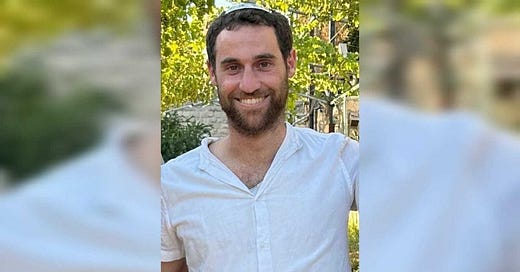




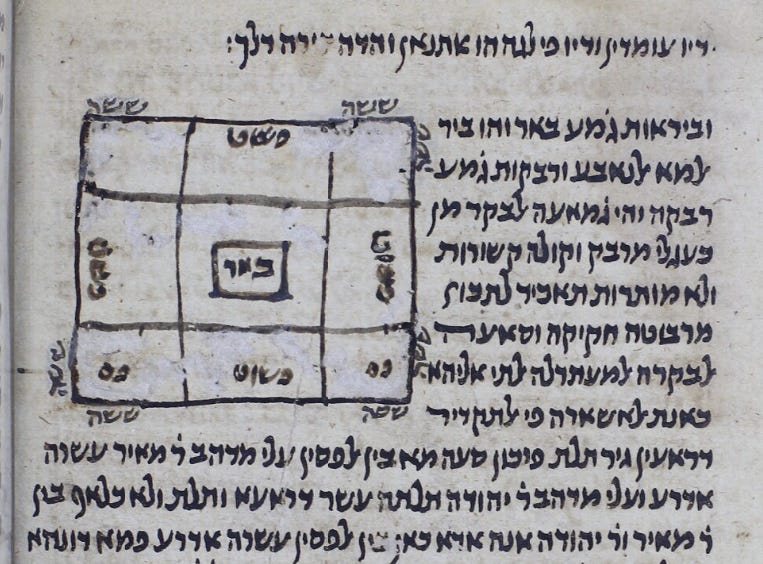








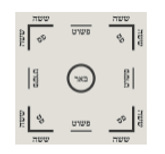
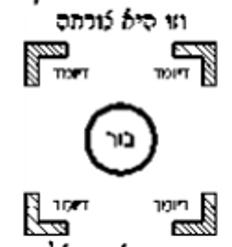

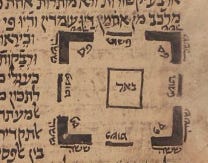







Indeed, quite amazing. I looked at some pages in random (eg, Kilayim, Kelim), and saw notations everywhere and numerous diagrams and pictures. Clearly this was an אדם גדול מאד.
איך נפלו גבורים בתוך המלחמה
הי"ד